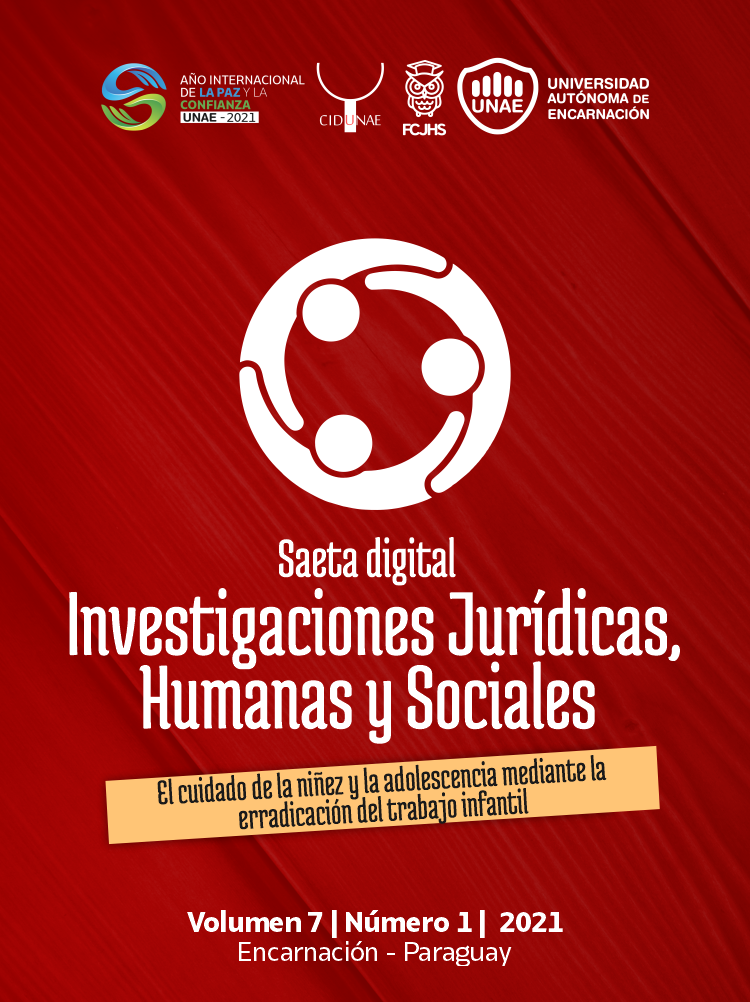ASPECTOS DO TRABALHO INFANTIL NO BRASIL: QUEM SÃO E ONDE ESTÃO AS CRIANÇAS E OS ADOLESCENTES EXPLORADOS?
Palabras clave:
Infância e adolescência – Pobreza – Exploração – Violação de direitos humanos.Resumen
O trabalho infantil é um problema persistente e histórico na sociedade brasileira, especificamente no que toca a um grupo de crianças e adolescentes: ele se entrelaça, sobretudo, na realidade dos mais pobres. Diferente de outros males que acometem indistintamente as infâncias, a exemplo da violência sexual, a problemática do trabalho infantil é “privilégio” dos mais carentes, daqueles que são privados de recursos econômicos e de condições dignas para sua existência e pleno desenvolvimento. Farta literatura no Brasil aponta para a presença e os malefícios do trabalho infantil, a tolher e impactar negativamente milhares de vidas em desenvolvimento. Não obstante isso, continuam a transitar nos imaginários sociais mitos, no aspecto de que o trabalho à criança (pobre) é bom e dignifica, sem o qual o caminho que lhe resta é o da criminalidade. Desde 1990, o Brasil conta com uma legislação protetiva da infância, pautada pelo paradigma da proteção integral, da concepção de que crianças e adolescentes são sujeitos de direitos, titulares de direitos humanos, fundamentais e também dos especiais, previstos em Estatuto. Todavia, a exploração da mão de obra infantil continua sendo um desafio no país. Dito isso, este estudo demonstra a relação entre trabalho infantil e infâncias em situação de pobreza. O objetivo da investigação é contribuir à necessária reflexão sobre as violações de direitos humanos a que submetido o público infantoadolescente, ao lado da possibilidade de intercâmbios de ideias. Para tanto, realizou-se uma revisão bibliográfica, pautada pelo método hipotético-dedutivo, para responder os seguintes questionamentos: como as normas brasileiras protegem meninas e meninos contra o trabalho infantil? Quais são as regiões brasileiras em que esta proteção mais tem se mostrado deficiente? Qual é a realidade social e econômica desse público? A investigação permitiu evidenciar que a própria Constituição Federal brasileira (1988) protege crianças e adolescentes do trabalho infantil, ao estipular idade mínima para o trabalho e determinadas condições a que os aprendizes não podem ser expostos. Ademais, a Constituição contém em seu teor a Doutrina da Proteção Integral, que zela pela dignidade deste público. No mais, normas infraconstitucionais, sobretudo o Estatuto da Criança e do Adolescente, e internacionais, das quais o Brasil é signatário, igualmente destacam que toda(o) criança e adolescente têm direito a receber proteção contra a exploração econômica e contra qualquer trabalho perigoso ou prejudicial ao seu bem-estar. No entanto, a realidade social conflita com esta perspectiva normativa, conforme evidenciado pelo Unicef. Através de pesquisa publicada em 2018, o Fundo destacou que, no Brasil, 6,2% das crianças e adolescentes de 5 a 17 anos exercem trabalho infantil. A carga de trabalho é maior entre meninas, exceto no que toca ao trabalho remunerado, que é maior entre meninos; ademais, infantoadolescentes negros trabalham mais que brancos. A problemática se mostra presente em todas as cinco regiões brasileiras, mas se concentra especialmente nas regiões Norte e Nordeste, bem como em zonas rurais.
Palavras-chave: Infância e adolescência – Pobreza – Exploração – Violação de direitos humanos.
Citas
Brasil. (2021a). Constituição da República Federativa do Brasil de 1988. Brasília, DF: Assembleia Nacional Constituinte. Recuperado de: http://www.planalto.gov.br/ccivil_03/constituicao/constituicaocompilado.htm.
Brasil. (1990a). Decreto n. 99.710, de 21 de novembro de 1990. Promulga a Convenção sobre os Direitos da Criança. Brasília, DF: Presidência da República, 22 nov. 1990. Recuperado de: http://www.planalto.gov.br/ccivil_03/decreto/1990-1994/d99710.htm.
Brasil. (1990b). Lei nº 8.069, de 13 de julho de 1990. Estatuto da Criança e do Adolescente. Recuperado de: http://www.planalto.gov.br /ccivil_03/leis/L8069.htm.
Brasil. (2016). Transformando nosso mundo: a Agenda 2030 para o desenvolvimento sustentável. Brasília: Governo Federal.
Fundo das Nações Unidas para a Infância. (2018). Bem-estar e privações múltiplas: na infância e na adolescência no Brasil. Brasília: Autor. Recuperado de: https://www.unicef.org/brazil/media/2061/file/Bem-estar-e-privacoes-multiplas-na-infancia-e-na-adolescencia-no-Brasil.pdf.
Fundo das Nações Unidas para a Infância. (2020). UNICEF alerta para o risco de aumento do trabalho infantil durante e após a pandemia. Brasília: Autor. Recuperado de: https://www.unicef.org/brazil/comunicados-de-imprensa/unicef-alerta-para-o-risco-de-aumento-do-trabalho-infantil-durante-e-apos.
Instituto Brasileiro de Geografia e Estatística. (2021a). Comissão Nacional de Classificação – CONCLA. Recuperado de: https://cnae.ibge.gov.br/en/component/content/article/94-7a12/7a12-vamos-conhecer-o-brasil/nosso-territorio/1461-o-brasil-no-mundo.html.
Instituto Brasileiro de Geografia e Estatística. (2021b). Instituto Brasileiro de Geografia e Estatística. Recuperado de: https://www.ibge.gov.br/.
Schwarcz, L. M. (2019). Sobre o autoritarismo brasileiro. São Paulo: Companhia das Letras.
Publicado
Número
Sección
Licencia
La responsabilidad del contenido de los artículos publicados es de competencia exclusiva de los firmantes del artículo y de ninguna manera será atribuible a la Editora o al Comité Editorial de la revista.
Los autores de los artículos son los responsables de la obtención del permiso correspondiente para incluir en su artículo cualquier material publicado en otro lugar. La revista declina cualquier responsabilidad que se derive de la posible falta de permiso en la reproducción de cualquier material.
Los autores ceden a la Revista la propiedad de sus derechos de autor, para que los artículos sean publicados en cualquier forma o medio.
La Revista se reserva todos los derechos de autor y la reproducción de los documentos en otros medios impresos y/o electrónicos que debe estar autorizada por el Editor.

